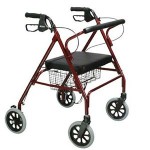Proposed Functional Scoring in the Edmonton Obesity Staging System
Monday, April 23, 2012 As regular readers may be well aware, the Edmonton Obesity Staging System (EOSS), now validated against several large prospective datasets including NHANES III, NHANES (1999–2004), and the Cooper Clinic Longitudinal Study, is a far better indicator of mortality risk in overweight and obese individuals than BMI, waist circumference, or even metabolic syndrome.
As regular readers may be well aware, the Edmonton Obesity Staging System (EOSS), now validated against several large prospective datasets including NHANES III, NHANES (1999–2004), and the Cooper Clinic Longitudinal Study, is a far better indicator of mortality risk in overweight and obese individuals than BMI, waist circumference, or even metabolic syndrome.
While determining EOSS stages for medical conditions such as hypertension, diabetes, or dyslipidemia is relatively straightforward and can be based on (more or less) accepted definitions within these conditions, scoring of physical function may be more complicated.
In our original proposal, we had recommended that functional limitations could be scored by the provider using clinical judgement as being either absent (Stage 0), mild (Stage 1), moderate (Stage 2), severe (Stage 3), or disabling/endstage (Stage 4).
However, I understand that for research (and perhaps even in clinical settings), one may wish to simplify and be more specific about what exactly entails ‘mild’, ‘moderate’, or ‘severe’.
In this context, I was quite intrigued by the findings of the impact of weight management on mobility in individuals with type 2 diabetes in the LookAHEAD study recently published in the New England Journal of Medicine.
Here is how the authors describe the assessment of mobility in that paper:
“Mobility was assessed on the basis of 6 of 11 items on the Medical Outcomes Study 36-Item Short-Form Health Survey (SF-36) Physical Functioning. The items included vigorous activity, such as running and lifting heavy objects; moderate activity, such as pushing a vacuum cleaner or playing golf; climbing one flight of stairs; bending, kneeling, or stooping; walking more than a mile; and walking one block. Participants were assigned a score of 1 on items for which they reported not being limited at all or a score of 0 on items for which they indicated having any limitation.”
Based on this assessment, the authors determined four states of disability with the following criteria:
“To render the model more clinically useful, it was reduced to four states that were sequential and progressively ordered from the healthiest to the most severe state of disability. In state 1 (good mobility), participants were somewhat unable to perform vigorous physical activities. In state 2 (mild mobility-related disability), participants had problems in bending and long-distance walking. In state 3 (moderate mobility-related disability), participants had deficits in many tasks and some deterioration in the ability to climb stairs and engage in moderately demanding activities. In state 4, participants had severe limitations, with difficulty in nearly all tasks.”
They further went on to describe the clinical relevance of these disability states:
“Using baseline data, we examined the clinical relevance of the four-state model. Moving from state 1 to state 4, the average body-mass index (BMI, the weight in kilograms divided by the square of the height in meters) increased progressively (33.83, 36.07, 37.39, and 38.79, respectively), as did the number of coexisting medical conditions (1.18, 1.44, 1.70, and 1.84). The estimated maximal MET capacity from state 1 to state 4 decreased linearly (8.16, 7.13, 6.52, and 5.94, respectively), and the ratio of women was disproportionately higher in state 4 than in state 1: although women constituted 50.0% of the good-mobility category, they constituted 72.0% of the severe-disability category.”
I believe, based on these findings, that these very criteria could be easily adopted for defining functional status in EOSS as follows:
EOSS Stage 0: no functional limitations
EOSS Stage 1: (good mobility) somewhat unable to perform vigorous physical activity (e.g. running and lifting heavy objects)
EOSS Stage 2: (mild mobility related disability) problems in bending and long-distance walking (>1 mile/1.5 Km)
EOSS Stage 3: (moderate mobility related disability) problems in climbing one set of stairs.
EOSS Stage 4: (severe mobility related disability) problems in walking one block.
How well these functional criteria overlap with other existing medical or mental comorbidities in overweight individuals and whether or not these functional criteria add to the discriminatory power of EOSS to determine mortality risk in overweight and obese patients, will need to be further validated and I would certainly be most interested in hearing from any readers who may perhaps wish to conduct such a research project or further validate this idea.
Clearly, functional limitations in overweight and obese individuals are not only common but can also impact other dimensions of health including physical fitness, mental health, and quality of life, and should therefore be taken into account in determining weight management strategies.
AMS
Edmonton, Alberta


